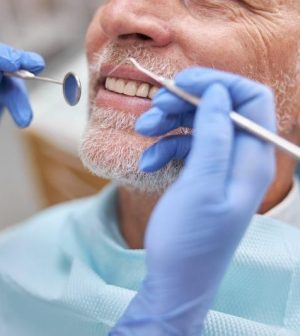- Skip Storing This Everyday Product in the Fridge Door
- Green Tea + B3 Pairing May Boost Brain Health
- Navigating Your Midlife Crisis: Embracing New Possibilities
- City Raccoons Showing Signs of Domestication
- Mapping the Exposome: Science Broadens Focus to Environmental Disease Triggers
- One Week Less on Social Media Linked to Better Mental Health
- Your Brain Changes in Stages as You Age, Study Finds
- Some Suicide Victims Show No Typical Warning Signs, Study Finds
- ByHeart Formula Faces Lawsuits After Babies Sickened With Botulism
- Switch to Vegan Diet Could Cut Your Greenhouse Gas Emissions in Half
Stem Cells Might Someday Create New Tooth Enamel or ‘Living Fillings’

Damaged teeth could one day be repaired with “living fillings” created from stem cells, a new study reports.
In the lab, researchers induced stem cells to form small, multicellular mini-organs that secrete the proteins that form tooth enamel, according to a report published Aug. 14 in the journal Developmental Cell.
“This is a critical first step to our long-term goal to develop stem cell-based treatments to repair damaged teeth and regenerate those that are lost,” co-author Dr. Hai Zhang, a professor of restorative dentistry at the University of Washington School of Dentistry, said in a school news release.
Tooth enamel is the hardest tissue in the human body. It protects teeth from the mechanical stresses of chewing and helps them resist decay, researchers said in background notes.
Enamel is made during tooth formation by special cells called ameloblasts. The cells die off when teeth are finished growing, leaving the body no way to repair or regenerate damaged enamel.
The goal of this research was to create ameloblasts in the laboratory.
For starters, researchers used RNA sequencing to figure out why some fetal stem cells develop into these highly specialized enamel-producing cells.
Through this sequencing, they created a series of “snapshots” that tracked each stage of cell development as well as the genes that are active at those stages.
Computer analysis then worked out the likely series of gene activities that would need to occur for stem cells to develop into an ameloblast.
“The computer program predicts how you get from here to there, the roadmap, the blueprint needed to build ameloblasts,” said project leader Hannele Ruohola-Baker, a professor of biochemistry and associate director of the UW Medicine Institute for Stem Cell and Regenerative Medicine.
Following the path laid out by the computer analysis, researchers after much trial and error coaxed undifferentiated human stem cells into becoming ameloblasts.
They did this by using chemical signals that activated different genes in the stem cells, mimicking the path of natural development.
The researchers also identified for the first time a tooth cell type called a subodontoblast, which appears to be a precursor of odontoblasts, a cell type crucial for tooth formation.
Together, as they developed, the cells formed small, three-dimensional, multicellular mini-organs called organoids.
These organoids assembled themselves into structures similar to those seen in developing human teeth, and began secreting three proteins essential to enamel: ameloblastin, amelogenin and enamelin.
The proteins then began to form up and mineralize, a step that’s essential for forming hard tooth enamel.
By refining the process, the research team hopes to make an enamel as durable as that found in natural teeth, and then develop ways to use this enamel to restore damaged teeth, Zhang said.
Lab-created enamel could one day be used to fill cavities and other defects. An even more ambitious goal would be to create “living fillings” that would grow and repair cavities, Ruohola-Baker said in the release.
Such “living fillings” might even be used to grow stem cell-derived teeth that could replace lost teeth entirely.
“This may finally be the ‘Century of Living Fillings’ and human regenerative dentistry in general,” Ruohola-Baker added.
More information
HealthDay has more on fixing a broken tooth.
SOURCE: University of Washington School of Medicine, news release, Aug. 14, 2023
Source: HealthDay
Copyright © 2025 HealthDay. All rights reserved.










